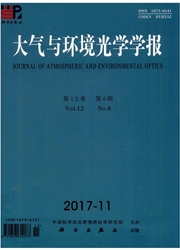

 中文摘要:
中文摘要:
Stephen在2008年提出了一种新型亮温经验函数,为反演云底高提供了一种无需计算大气中实时水汽含量的新方法。利用SBDART模式和Stephen亮温函数比较系统地研究了不同天顶角、水汽、云、气溶胶、能见度等气象要素条件下,云底红外亮温T_b随天顶角的变化情况,并对其进行误差分析。模拟结果显示,水汽、云、天顶角及能见度小于5 km时对T_b影响较大,不同气象要素条件下,Stephen亮温函数模拟的云底亮温与SBDART模拟结果相近,所以,采用Stephen亮温函数模拟云底亮温具有可行性。
 英文摘要:
英文摘要:
In 2008, Stephen put forward a new brightness temperature function and the expression is purely empirical. However, it does not require knowledge of the total amount of atmospheric water vapor in retrieval of cloud-base height. Systematical investigation of the changes of the cloud-based infrared brightness temperature Tb as the zenith angle, water vapor, cloud, aerosol, visibility and other meteorological conditions is performed by using the SBDART model and Stephen brightness temperature function, and the error is analyzed. The results show that zenith angle, water vapor, cloud, aerosol and visibility less than 5 km have a very important influence on Tb. Under different meteorological conditions, the simulation results of Stephen function are similar to SBDART model. Therefore, Stephen brightness temperature function can be used to simulate the cloud-base brightness temperature
 同期刊论文项目
同期刊论文项目
 同项目期刊论文
同项目期刊论文
 期刊信息
期刊信息
